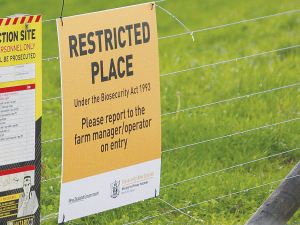We must keep our foot on the pedal
OPINION: Last week marked a major step forward in our work to eradicate Mycoplasma bovis.
 An independent review has confirmed appropriate steps have been taken by the M. bovis Programme to remove infection in Wakanui.
An independent review has confirmed appropriate steps have been taken by the M. bovis Programme to remove infection in Wakanui.
An independent review into Mycoplasma bovis infection in Wakanui, mid-Canterbury, shows appropriate steps are being taken to remove infection in the area, says M. bovis Programme director Simon Andrew.
The review was commissioned by the programme’s partners, MPI, DairyNZ, and Beef + Lamb NZ, in mid-2022 after it became apparent infection was circulating in a small geographical area despite the use of disease control measures, which have proven successful in other areas around New Zealand.
“The review, carried out by independent epidemiologist Dr Jonathan Happold, has endorsed the approach we are taking in the Wakanui area,” Andrew says.
“While the review did not confirm the sources of infection in Wakanui, it notes that the area has been unique to other parts of New Zealand, which have experienced M. bovis infection,” he says.
Andrew says Wakanui had a large, concentrated and dynamic population of infected animals within the local feedlot and there was a small cluster of Confirmed Properties, most of which have paddocks within 1.5km of the feedlot.
Dr Happold concluded the unusually high amount of infection on the Five Star Beef feedlot could have allowed for airborne transmission that is highly unlikely to have occurred in other areas of New Zealand.
“The review has not determined the transmission routes occurring in Wakanui with any certainty, and it is possible we may never be able to categorically says what the transmission route is,” Andrew says.
“What we do know is, eradication is not dependent on knowing the transmission route. What is important is that we remove the infection from the area which is exactly what we’re doing.”
As part of the review, Happold also looked at a range of transmission routes, including mechanical vectors like birds and flies, manure, effluent, and groundwater. The review concluded infection is unlikely to have occurred via these routes.
“Dr Happold supports the depopulation plan for Five Star Beef and the use of a Controlled Area Notice (CAN). He made several recommendations and most of these have already been implemented,” Andrew says.
Andrew says the eradication effort continues to make good progress, with the high-risk area of the CAN now free of cattle and the CAN set to be lifted in mid-March.
“It is expected all current Confirmed Properties are likely to be cleared within the first half of the year,” he says.
“While the job is far from over, we are as close to moving to the next phase of the eradication as we have ever been and the collective effort from farmers, industry and Programme staff has helped us get to where we are today."
The National Wild Goat Hunting Competition has removed 33,418 wild goats over the past three years.
New Zealand needs a new healthcare model to address rising rates of obesity in rural communities, with the current system leaving many patients unable to access effective treatment or long-term support, warn GPs.
Southland farmers are being urged to put safety first, following a spike in tip offs about risky handling of wind-damaged trees
Third-generation Ashburton dairy farmers TJ and Mark Stewart are no strangers to adapting and evolving.
When American retail giant Cosco came to audit Open Country Dairy’s new butter plant at the Waharoa site and give the green light to supply their American stores, they allowed themselves a week for the exercise.
Fonterra chair Peter McBride says the divestment of Mainland Group is their last significant asset sale and signals the end of structural changes.